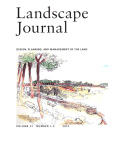
Interiors-Design Architecture Culture
Scope & Guideline
Exploring the Intersection of Space and Culture
Introduction
Aims and Scopes
- Cultural and Historical Analysis of Interiors:
The journal emphasizes the significance of cultural narratives and historical contexts in understanding interior spaces. It examines how different cultures and historical periods influence design practices and the meanings ascribed to various interior environments. - Interdisciplinary Approaches to Design:
The journal promotes interdisciplinary research, merging insights from architecture, design studies, sociology, and environmental psychology. This approach allows for a richer understanding of how interiors affect and are affected by human behavior and social dynamics. - Sustainability and Environmental Concerns:
A core focus of the journal is on sustainable design practices, environmental ethics, and biophilic design, reflecting a growing awareness of ecological issues within the field of interior design and architecture. - Innovative Spatial Practices:
The journal explores contemporary and innovative design practices, including the integration of technology and new materials in creating dynamic and adaptable interior spaces. - Community and Social Dimensions of Interiors:
Research published in the journal often addresses the social aspects of interiors, including community engagement, inclusivity, and the role of design in enhancing social interactions.
Trending and Emerging
- Ecological and Biophilic Design:
There is a notable increase in research exploring ecological design practices and biophilic principles, emphasizing the integration of nature into interior spaces to enhance well-being and sustainability. - Multispecies and Community Engagement:
Emerging studies focus on multispecies interactions within interior environments and the role of communal spaces in fostering social connections, reflecting a shift towards inclusive and participatory design. - Digital and Augmented Interiors:
The exploration of digital technologies and their impact on interior design is gaining traction, including discussions on virtual spaces and the implications of technology on user experiences. - Critical and Reflective Practices in Design:
A growing trend towards critical reflection on design practices is evident, with an emphasis on questioning norms and exploring the socio-political implications of interior environments. - Health and Well-being in Interior Design:
Research increasingly emphasizes the intersection of interior design with health and well-being, exploring how interiors can promote mental and physical wellness, particularly in the wake of the COVID-19 pandemic.
Declining or Waning
- Traditional Domestic Spaces:
There appears to be a diminishing emphasis on traditional domestic interiors, as contemporary research increasingly focuses on innovative and flexible living spaces rather than conventional home layouts. - Static Interior Design Concepts:
The journal has seen less focus on static or fixed design concepts. Instead, there is a growing interest in adaptable and fluid spaces that cater to changing user needs and lifestyles. - Historical Preservation of Interiors:
Although historical analysis remains important, the emphasis on the preservation of interiors as fixed entities has waned, giving way to discussions on the reinterpretation and transformation of historical spaces. - Gendered Spaces in Interior Design:
While gender dynamics in design were previously highlighted, there has been a noticeable decline in papers specifically addressing gendered spaces, as the discourse shifts towards broader societal impacts of design. - Luxury and Opulence in Interiors:
The focus on luxury and high-end design has decreased, with more emphasis being placed on equitable and sustainable design practices that prioritize accessibility and community needs.
Similar Journals

Landscape Architecture Frontiers
Redefining public spaces with critical insights.Landscape Architecture Frontiers, an esteemed journal published by Higher Education Press, serves as a pivotal platform for the dissemination of innovative research and critical thinking within the field of landscape architecture. Recognized for its commitment to advancing global discourse on sustainable design, environmental stewardship, and urban ecology, the journal's content is crucial for researchers, professionals, and students alike who are dedicated to shaping the future of landscape architecture. With a diverse range of topics covered, including landscape planning, restoration ecology, and cultural landscapes, this journal aims to foster interdisciplinary collaboration and promote best practices in the discipline. Although specific metrics like the impact factor and HIndex are not provided, the journal's reputation within the academic community underlines its significance in contributing to ongoing education and professional development in landscape architecture. For those interested in open access options, Landscape Architecture Frontiers encourages engagement and wider readership through its research, making it an essential resource for anyone passionate about the transformative power of landscapes and public spaces.

LOTUS INTERNATIONAL
Exploring the Intersection of Creativity and TheoryLOTUS INTERNATIONAL is a distinguished journal published by EDITORIALE LOTUS, focusing on the dynamic fields of Architecture and Visual Arts and Performing Arts. With its ISSN 1124-9064, this scholarly periodical has been a platform for innovative research and discourse since its inception in 2002, resuming publication in 2021 after a brief hiatus. Based in the cultural hub of Milan, Italy, LOTUS INTERNATIONAL aims to bridge theoretical frameworks and practical applications, thereby fostering a deeper understanding of creative practices and their implications in modern society. As a Q4 ranked journal in its respective categories for 2023, it provides a unique opportunity for researchers and professionals to contribute to an evolving dialogue, even at the foundational percentile levels within its Scopus rankings. Although not an open-access journal, LOTUS INTERNATIONAL remains committed to disseminating valuable insights and advancing knowledge in the creative disciplines. With an accessible format, it invites a diverse audience, including students, to engage with emerging concepts that shape the future of art and architecture.

Landscape Journal
Cultivating Research for a Greener FutureWelcome to the Landscape Journal, a prominent publication in the field of Nature and Landscape Conservation, proudly brought to you by University of Wisconsin Press. Since its inception, this journal has strived to underpin the critical interplay between environmental science and landscape architecture, providing a platform for innovative research and comprehensive insights. With an ISSN of 0277-2426 and an E-ISSN of 1553-2704, the Landscape Journal is indexed in leading academic databases and recognized with a 2023 Scopus Rank of #167, placing it in the 21st percentile among its peers. The journal operates from the heart of the United States, featuring converged years from 2009 to 2019 and again from 2021 to 2024, making it a reliable resource for ongoing dialogue in landscape studies. Although it currently does not offer open access, the Landscape Journal remains an essential resource for researchers, professionals, and students dedicated to understanding and enhancing our natural environments. As a Q3 category journal, it invites contributions that push the boundaries of landscape research while fostering environmental stewardship.

Revista 180
Pioneering Research in Visual and Performing ArtsRevista 180 is a distinguished academic journal published by UNIV DIEGO PORTALES in Chile, focusing on the critical intersections of architecture, urban studies, and visual and performing arts. With its ISSN of 0718-2309, this journal has consistently contributed to advancing knowledge in its respective fields since its inception in 2005, and will continue to do so until 2024. Highlighting its prestige, Revista 180 holds notable rankings in the Scopus database—placing in the 77th percentile in Visual Arts and Performing Arts and Q1 category, along with respectable Q2 and Q3 rankings in Architecture and Urban Studies, respectively. The journal serves as a vital platform for researchers, professionals, and students, fostering scholarly dialogue and innovation. As it operates under a traditional subscription model, it continues to emphasize the importance of accessible, high-quality research. By publishing rigorous and impactful research, Revista 180 plays a crucial role in shaping academic discourse in the arts and humanities.

Dearq
Connecting Scholars to Inspire Socio-Environmental ChangeDearq, an esteemed academic journal published by UNIV ANDES, is recognized as a vital source of knowledge in the fields of Architecture, Geography, Planning, and Urban Studies. As an Open Access journal since its inception in 2007, it provides researchers, professionals, and students with a platform to disseminate high-quality research that fosters innovation and progress in these dynamic disciplines. With an impressive track record of converging research from 2019 to 2024, Dearq currently holds a Q2 ranking in Architecture and Q3 rankings in both Geography, Planning, and Development, as well as Urban Studies for 2023. This editorial momentum reflects its commitment to advancing scholarly dialogue and critical inquiry. Located in Colombia and fostering a global perspective, Dearq is dedicated to enriching the academic landscape, making it an indispensable resource for anyone seeking to explore and understand complex socio-environmental issues.

ARCHITECTURAL DESIGN
Connecting Theory and Practice in ArchitectureARCHITECTURAL DESIGN, a leading journal published by Wiley Periodicals, Inc., serves as a vital platform for discourse in the fields of architecture and visual arts. With an ISSN of 0003-8504 and an E-ISSN of 1554-2769, this esteemed publication offers comprehensive insights into contemporary design practices and emerging architectural theories. Established in the United States and continuously evolving from 2002 to 2024, the journal has secured a prominent position with a Q3 status in Architecture and an impressive Q1 ranking in Visual Arts and Performing Arts as of 2023. Its Scopus rankings further affirm its relevance, with a percentile ranking of 82nd in the Visual Arts category. Although it does not currently offer Open Access options, the journal remains dedicated to disseminating high-caliber research and innovative design strategies that engage a diverse readership of researchers, professionals, and students alike. The contributions published within its pages are instrumental in shaping the discourse around architecture, making ARCHITECTURAL DESIGN an indispensable resource for anyone passionate about the built environment.

En Blanco-Revista de Arquitectura
Fostering Dialogue Among Architects and DesignersEn Blanco - Revista de Arquitectura is a peer-reviewed journal published by UNIV POLITECNICA VALENCIA, EDITORIAL UPV, specializing in the field of architecture and design. This esteemed publication aims to bridge theoretical advances and practical applications within the architecture domain, showcasing innovative research, critical essays, and multidisciplinary approaches. With an emphasis on fostering dialogue among researchers, professionals, and students, En Blanco serves as an essential platform for disseminating cutting-edge ideas and discussions that define contemporary architectural practices. Although currently offering non-open access content, the journal is dedicated to promoting accessibility through insights that resonate beyond its pages. With an ISSN of 1888-5616 and E-ISSN of 2445-1215, En Blanco is a pivotal resource for any architecture enthusiast looking to enrich their understanding and contribute to the evolving discourse in architectural studies.

Landscape Architecture and Art
Celebrating the Fusion of Ecology and Visual ArtsLandscape Architecture and Art is a distinguished journal published by the Latvia University of Life Sciences and Technologies, specializing in the intersection of landscape architecture, environmental design, and the visual arts. Established in 2016, this journal has rapidly garnered recognition in various academic categories, achieving Q3 ranking in Agricultural and Biological Sciences (miscellaneous), Q4 in Geography, Planning and Development, and notably Q1 in Visual Arts and Performing Arts as of 2023. With its ISSN 2255-8632 and E-ISSN 2255-8640, the journal provides an essential platform for researchers, professionals, and students to explore innovative approaches and sustainable practices in landscape design and conservation. Although currently not open access, the journal's commitment to high-quality research is evident through its impressive Scopus rankings, particularly in the Arts and Humanities with a commendable 88th percentile for Visual Arts and Performing Arts. Located in Jelgava, Latvia, this journal serves as a vital resource for advancing knowledge and fostering collaboration in the fields of landscape architecture and environmental stewardship.

DESIGN ISSUES
Cultivating Critical Insights for Design PractitionersDESIGN ISSUES, published by MIT PRESS, serves as a vital platform for scholarly discourse within the realms of design, arts, and humanities. With an ISSN of 0747-9360 and an E-ISSN of 1531-4790, this journal has established itself as a critical resource for researchers and practitioners alike, maintaining a significant presence in the academic community. As of 2023, it is ranked in the second quartile in Arts and Humanities (Miscellaneous) and the fourth quartile in Computer Graphics and Computer-Aided Design, showcasing its diverse scope and interdisciplinary approach. Spanning converged years from 2005 to 2024, DESIGN ISSUES fosters an exploration of contemporary design debates, theoretical advancements, and case studies, ensuring that it remains relevant and insightful amid the fast-evolving landscape of design practices. While not an open access journal, it is dedicated to enriching the academic and professional realms by engaging with pressing design issues, making it an essential read for anyone invested in the future of design.

ARCHITECTURAL RECORD
Inspiring the Next Generation of Architectural ThoughtARCHITECTURAL RECORD, published by McGraw Hill Inc, stands as a vital resource in the field of architecture and design, offering insightful perspectives and critical analyses that cater to architects, designers, and academia alike. With an ISSN of 0003-858X, this prestigious journal has been a cornerstone for the architectural community, providing a blend of contemporary practices and theoretical frameworks since its inception. Although it is not currently available through Open Access, its rich content contributes to the ongoing dialogue in both the Visual Arts and Performing Arts, as well as Engineering and Architecture disciplines. The journal's historical impact can be seen through its wide readership and influence in shaping architectural discourse, making it a highly regarded publication for professionals and students in the field. As a beacon of innovative practices, ARCHITECTURAL RECORD continues to inspire and educate, even despite its coverage discontinuation in Scopus since 2018.